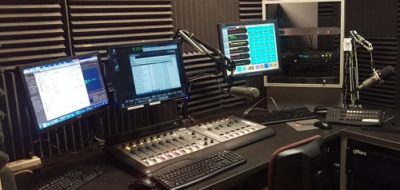By Scott Foster; Vice President, Corporate Engineering Salem Media Group
New facility built around Livewire AoIP products
WASHINGTON — The Salem Media Group has been dabbling in the world of AoIP for a while. We started out replacing a studio here or there with Axia Audio Livewire products. We then moved to doing individual new studio build-outs with Axia. Most recently, we went all-in with Axia for our Washington facility.
We took this gradual approach to ensure the system could do what we needed, to test user experiences and to evaluate fully the costs involved.
Our D.C. facility uses Axia RAQ and iQ control surfaces, QOR32 engines, StudioEngine DSP mixing engines, xNodes along with AudioScience Livewire-compatible soundcards, 25-Seven delays, Telos ProFiler software, a Telos VX broadcast phone system and Z/IP One IP codecs.
All of these products use the Axia Livewire AoIP protocol, so we didn’t do any integration using AES67 protocol. When I said we went all-in, I meant that this plant had no backup hardwired audio switchers and only had five punch blocks in the entire facility. To give you some perspective, Axia is running four terrestrial stations, one XM satellite radio channel, one nationally syndicated talk show and a news bureau that feeds about 2,000 affiliates.
The IP address structure was laid out ahead of time so when the gear was unpacked and racked, addresses were already assigned. The xNode interfaces went easily using the Power over Ethernet feature, which allowed us to cut down the number of outlets needed in racks and furniture. Surfaces were connected to engines and powered up.
One issue we did have was the length of the CAN bus cable. The longest offered is 40 feet, but out editor desk was going to be about 55 feet from the engine. Ad there is some wizardry going on with the connectors, we just spliced a chunk in the middle and everything has worked fine so far.
CONFIGURATION
All the devices have a web interface, so once the gear is up on the Axia Livewire network, it is configured easily from a computer sitting on the same network. In some of our other facilities we have Axia Element control surfaces as well as iQs. The configuration pages are not the same and don’t fall in the same order between these two surfaces. This takes some thought when you are switching quickly from one unit to the next.
In out D.C. plant, all the configuration pages for the surfaces worked the same. Once we learned the process, it was just a matter of getting the sources entered and destinations assigned.
In out talk studios, we like to set up the talkback so that the board operator can talk directly to the host without the guests hearing. Some of our hosts can operate their own board; the board op controls the levels on others. The combination of these two things, plus headphones and remote control mic, runs us right up against the limits of network sources in the iQ surface.
The iQ can be configured to be the destination for eight network sources at any given time, and give eight sources to the network. It can also be configures to be the destination for 12 sources on the surface and provide sour sources to the network. To get around this limitation, we have started putting in StudioEngines to take advantage of the unlimited VMix function. This allows us to use the headphone feeds on the network and mix them down to one network source. So instead of chewing up two or three sources in the iQ, we shove this off to the StudioEngine and only use up one source. We’re also looking forward to trying the xNode’s new Matrix Mixer functionality, which mixes both physical and network inputs.
All in all we are very happy with the product. The tech support is top-notch and Axia goes away above what they have to do to make you happy. I don’t think we would have been able to go from furniture delivery to working facilities in under 30 days without the help of Axia and Livewire.
via Radio World


